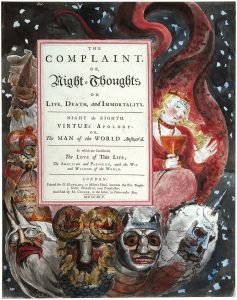The William Blake Archive is pleased to announce the publication of a digital edition of Blake’s water color drawings illustrating Edward Young’s The Complaint, and the Consolation; or, Night Thoughts. These 537 designs are a considerable proportion of Blake’s total production as a visual artist. The water colors join two copies of Blake’s engraved illustrations to Edward Young’s Night Thoughts (1797) previously published in the Archive, one uncolored and one with contemporary hand coloring.
Although there are no extant documentary records of the contract, it was probably in late 1794 or early 1795 that the publisher Richard Edwards commissioned Blake to illustrate a new, deluxe edition of Edward Young’s long meditative poem, first published in 1742-45. This was the largest commercial endeavor for which Blake was ever employed. Edwards began the project by having the pages from the first and second editions of the poem glued into windows cut into large leaves of Whatman wove paper. With what must have been enormous energy, Blake filled these large marginal spaces with 537 water color designs illustrating the poem’s nine sections, which Young called “Nights.” Blake was paid the paltry sum of twenty guineas for his water colors, presumably because he expected to receive a great deal more for engraving them.

Illustrations to Edward Young’s Night Thoughts, Object 345
All the water colors may not have been completed by the spring of 1796, but Blake began at that time to etch and engrave a selection of forty-three designs illustrating the first four Nights. These were published by Edwards in 1797 in the first of four intended large quarto volumes. Before any further volumes could be produced, Edwards closed his publishing business. Blake’s disappointment must have been profound. The failure of the Night Thoughts project may have been one of the reasons why Blake decided, in 1800, to move from London to the village of Felpham on the Sussex coast and place himself under the patronage of William Hayley.
While Blake based his designs closely on the text, many of the images draw upon personifications or metaphors in the poem. This approach tends to literalize what is only a figure of speech in the text, thereby confounding conventional distinctions between the literal and the metaphoric. Further, Blake drew heavily on his own repertory of motifs and postures when illustrating Young, and thus there are many parallels between the Night Thoughts designs and the pictures in Blake’s illuminated books. The influence of the Night Thoughts project on Blake’s writings is most directly evinced by his division of his long manuscript poem, Vala or The Four Zoas, into nine Nights. That manuscript also contains forty-seven pre-publication proofs of the Night Thoughts engravings, with lines of The Four Zoas written in the text panels.
With the publication of the Night Thoughts water colors, the Blake Archive now contains all of his major series of illustrations of English poetry, including Robert Blair’s The Grave, Thomas Gray’s collected poems, the nine series based on five of John Milton’s poems, and Dante’s Divine Comedy. In addition, the Archive offers all four groups of designs for the Book of Job (both water color series, the pencil preliminary drawings, and the engravings) and a generous selection of Blake’s water colors and tempera paintings illustrating the Bible. The pictorial motifs in all these series are fully searchable. The addition of the Night Thoughts water colors to the group greatly expands the range of searchable images.
As always, the William Blake Archive is a free site, imposing no access restrictions and charging no subscription fees. The site is made possible by the University of North Carolina at Chapel Hill with the University of Rochester, the continuing support of the Library of Congress, and the cooperation of the international array of libraries and museums that have generously given us permission to reproduce works from their collections in the Archive.
Morris Eaves, Robert N. Essick, and Joseph Viscomi, editors
Joseph Fletcher, managing editor, Michael Fox, assistant editor
The William Blake Archive
